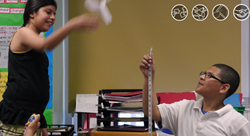New NSF-Backed Research Study Confirms that Project-Based Inquiry Curriculum Has a Positive Effect on How Students Learn Science


New York, NY (PRWEB) August 28, 2014
While educators and students across the country took off for summer vacation at the end of June, at the same time, a National Science Foundation-funded efficacy study on project-based curriculum (with major game-changing implications in education) was released, but not widely publicized.
The most profound finding to come out of the study indicates that students taught using project-based inquiry curriculum aligned with Next Generation Science Standards (NGSS) substantially outperformed students taught using a traditional science curriculum. The results of the research have broad-reaching implications for the entire education spectrum — from classroom and student engagement, to teacher Professional Development, to education policies at the state and national level.
The First Study of Its Kind
The independent, randomized controlled study conducted by SRI International*, compared the impact of the research-based, NGSS-aligned curriculum called Project-Based Inquiry Science™ (“PBIS”), published by IT’S ABOUT TIME® (“IAT”), to traditional science curriculum materials for middle-school students in a large and diverse urban school district. The study focused on two areas of science: earth science (processes that shape the Earth’s surface) and physical science (energy).
According to the efficacy study, educational research has shown that, nationwide, student interest and performance in science has traditionally declined in middle-grades. The decline is especially strong among students in low-income families and from groups underrepresented in STEM careers.
Participants monitored in this study included approximately 100 sixth-grade teachers and more than 3,000 sixth-grade students of various ethnicities and nationalities, across 42 middle schools in a district with a high percentage of low income families underrepresented in science, technology, engineering, and math (STEM) fields. The school district was comprised of 42% African American, 32% White, 18% Hispanic/Latino, and 6% Asian American students.
3 Big Takeaways
(1) Success: Students taught using the Project-Based Inquiry Science curriculum materials outperformed students who were taught using traditional science curriculum materials. Students in PBIS classrooms scored significantly higher on post-unit tests than students in traditional science curriculum classrooms.
(2) The Great Equalizer: Project-Based Inquiry Science curriculum can help close the learning gaps among students of underrepresented demographics in STEM courses and level the field between girls and boys. Unlike students using traditional science curriculum, the study results demonstrated that boys and girls using PBIS curriculum learned and tested at similar rates in the study as did students from different racial and ethnic backgrounds.
(3) Teacher/Student Engagement Increases: The study also demonstrated that teachers in the study using PBIS (who were all new to the curriculum) were more likely to engage their students in the following four science practices than non-PBIS teachers: constructing explanations, developing and using models, planning and carrying out investigations and asking questions. The research data also indicates that the difference in teacher/student engagement between PBIS and traditional science classes increased significantly over time.
What Do Students Need to Succeed in STEM Fields?
In addition to the research findings mentioned above, the study outlined recommendations for educators in strengthening student preparation for STEM fields, including the following:
(1) Students need expanded access to research-based materials, such as those developed with funding from the National Science Foundation and used in this study (PBIS). At present, only 6% of middle school teachers report having access to such materials, and more than half report that their textbooks are more than eight years old.
(2) There should be a focus on a limited number of disciplinary core ideas and crosscutting concepts that are explored through science and engineering practices over multiple years. Doing so will give students opportunities to build knowledge and revise their understanding over time.
(3) Materials must engage students in real-life science and engineering practices. Today, few students have opportunities to engage deeply in science and engineering practices, particularly those essential to developing science knowledge. Most traditional science instruction emphasizes memorization of discrete facts and focuses on a broad range of topics. This research shows that a project-based curriculum that offers students the opportunities to engage in real science and engineering practices has a positive effect.
(4) Teachers need access to high-quality professional development of extended duration that is focused on the science content to be taught. Teachers in this study (both treatment and control) participated in Professional Development workshops with positive results.
Moving Forward
Success with STEM is critical for 21st century education. As the demand for STEM career professionals grows, the need for science learning that prepares students for these fields also increases. This research reinforces the importance of connecting students to engaging, hands-on science curriculum that prepares them for real-world STEM careers and applications — opportunities typically not found in traditional science classrooms.
*Results from the first year results of a two-year evaluation.
ABOUT IT’S ABOUT TIME®
Founded in 1996, IT’S ABOUT TIME® specializes in providing research-based Science, Technology, Engineering, and Mathematics STEM curricula solutions for K-12 and college students, and partners with school districts to help educators adopt and implement them using Project-Based methods. Modeled on the way that practicing scientists and mathematicians conduct research, these solutions give educators tools to create a joyful learning environment and deepen student engagement and problem-solving skills. IAT’s curricula solutions empower over 14,000 teachers and 2 million students.